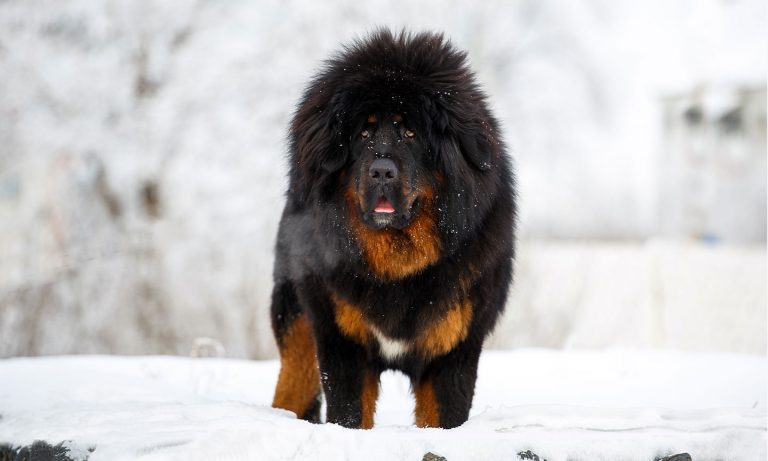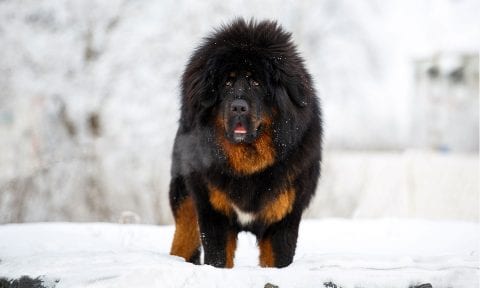Tibetan Mastiff vs Bullmastiff

Breed Snapshot
Best For
The majestic and independent Tibetan Mastiff makes a devoted family pet. Ranking among the largest dog breeds, they thrive with a job to do and plenty of room to roam.
Tibetan Mastiff Temperament
Tibetan Mastiffs are independent introverts who tend to be wary of strangers but are loving and loyal to their people. Though personality can vary from one dog to the next, these dogs tend to be headstrong and often think they know what’s best and view themselves more as equ...
Tibetan Mastiffs are independent introverts who tend to be wary of strangers but are loving and loyal to their people. Though personality can vary from one dog to the next, these dogs tend to be headstrong and often think they know what’s best and view themselves more as equal partners than pets.
Like all dogs, Tibetan Mastiffs require proper socialization from the time they’re a puppy. But with plenty of exposure to different people, pets and situations throughout their lives, they’ll be more accepting, though perhaps still aloof, reserving their affection for loved ones.
Pet parents need to be diligent about working with their pup to prevent biting tendencies. They have a bite force of 500 pounds, stronger than that of an American Pit Bull Terrier or German Shepherd, so even a playful bite could do major damage.
Tibetan Mastiff puppies can be taught to get along well with children and other pets when raised with them, but as adults, they may be less accepting of new dogs or other people’s children. And with their sheer size and strength it’s a good idea to supervise even well-socialized Tibetans around young children, cats or small dogs. Remember to teach all children how to interact gently and respectfully with dogs.
Their bossy natures make them a bad fit for obedience competitions, and they’re not built for agility or speed. But give these dogs some sheep, goats or cattle to guard, and watch them excel. They were bred to guard livestock, after all, and they’re at their best and happiest when they’re allowed to be watchful over their domain.
Tibetan Mastiff Traits

Breed Snapshot
Best For
Bullmastiffs, powerful and loyal, thrive on consistent training with their favorite person: you. These devoted and gentle giants are ideal for pet parents with plenty of space and time for training—and plenty of love...
Bullmastiffs, powerful and loyal, thrive on consistent training with their favorite person: you. These devoted and gentle giants are ideal for pet parents with plenty of space and time for training—and plenty of love to give.
Bullmastiff Temperament
Bullmastiffs are affectionate, happy-go-lucky dogs who form deep bonds with their humans and are faithful companions. A cross between the easy-going Old English Mastiff and the courageous Bulldog, the Bullmastiff dog is the perfect combination of their traits. This big softie isn’t much of a barker. They were bred to spot, trac...
Bullmastiffs are affectionate, happy-go-lucky dogs who form deep bonds with their humans and are faithful companions. A cross between the easy-going Old English Mastiff and the courageous Bulldog, the Bullmastiff dog is the perfect combination of their traits.
This big softie isn’t much of a barker. They were bred to spot, track and pin down poachers, and they had to be silent to achieve this mission—truly, they are the ninjas of the dog world. You wouldn’t know they were around, except they’re usually leaning against your leg or trying to fold themselves into your lap. (Wherever you are is their favorite place to be.) And don’t even think of leaving them outside on their own. They’ll be at the back door waiting for you to let them in.
Bullmastiffs are not really aggressive, nor are they known for biting (even though they have a powerful bite force). Like most working breeds, they are confident and self-assured, but can be wary of strangers. So, start training your Bullmastiff puppy early to help get them used to having visitors in your home.
Because they are large dogs who often think they are toy-sized, they can be a bit clumsy around small children, cats and smaller dogs. So, be sure to keep an eye out when your Bullmastiff dog is around anyone smaller than them, and teach children how to interact responsibly with dogs.




